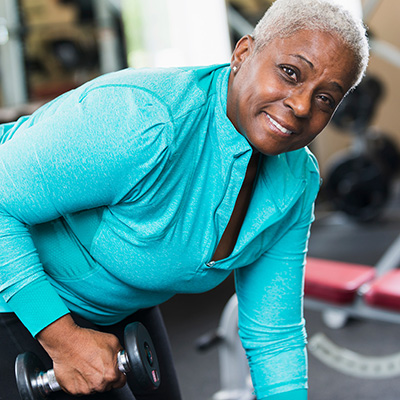Vitality eNews Sign Up
Receive the Summa Health eNewsletter for the latest health tips, advice and updates.
How Strong Are Your Bones? Get the Facts on Osteoporosis
Posted January 09, 2023 by Natalie Hiltbrand, MSN, APRN, FNP-C

How strong are your bones? You may have no idea until you break one doing some mundane activity, such as bumping into furniture, coughing or sneezing.
Osteoporosis is a bone disease that occurs when your body breaks down more bone than it creates. Bone is living tissue that is constantly broken down and replaced. The disease causes your bones to become weak and brittle, and breaking a bone doing seemingly ordinary activities is typically the first sign of osteoporosis.
Osteoporosis affects both males and females, but older females who are past menopause, are at the highest risk of the disease due to the drop in estrogen. It’s estimated about 54 million Americans have osteoporosis or low bone density, placing them at increased risk for fracture, according to the National Osteoporosis Foundation. What’s more, one in two females and up to one in four males will break a bone in their lifetime, due to osteoporosis.
Osteoporosis is often called a silent disease because you can’t feel or see your bones getting weaker, but once a bone breaks it can interfere with your daily activities and have serious consequences.
Summa Health breaks down osteoporosis, symptoms, risks factors and ways to manage and even help prevent this common disease. A healthy diet, rich in calcium and vitamin D, and regular exercise can go a long way to prevent bone loss and strengthen weak bones.
Osteoporosis symptoms
Typically, there are no symptoms in the early stages of bone loss. But as osteoporosis progresses, common symptoms can include:
- Back pain, caused by a fractured vertebra
- Loss of height over time
- Change in posture, such as a stooping or bending forward
- Bones that break more easily than expected, especially in the hip, wrist or spine
Osteoporosis risk factors
Osteoporosis can affect both males and females as they age. After about age 50, bone breakdown outpaces bone formation and bone loss often accelerates, especially in females post-menopause. In addition, males and females with small body frames tend to have a higher risk because they have less bone mass to draw from as they age.
Other risk factors for osteoporosis include:
- Family history
- Drop in sex hormones, such as estrogen and testosterone
- Diets low in calcium
- Sedentary lifestyles
- Excessive alcohol or tobacco use
- Eating disorders that severely restrict food
- Long-term use of steroids
- Certain medical conditions, such as celiac disease, rheumatoid arthritis, and kidney or liver disease
Managing or preventing osteoporosis
Good nutrition and regular exercise are essential for keeping bones healthy, helping to slow or stop the loss of bone mass, and reducing fracture risk.
To keep those bones strong, make sure to:
Get enough calcium and vitamin D in your diet.
Calcium is a key structural component of bone and plays a vital role in bone health. It’s especially important as we age because our body’s ability to absorb calcium declines.
The International Osteoporosis Foundation recommends post-menopausal females over the age of 51 and males over age 70 get 1,200 milligrams of calcium daily. For males up to age 70, 1,000 milligrams daily are recommended. Calcium should be consumed throughout the day, if possible, instead of all at once. Some individuals may have other medical conditions, such as kidney stones or kidney disease, that may affect the amount of daily calcium recommended. You should talk to your doctor or primary care provider before making any diet changes or starting any supplements.
Dairy is the main source of calcium, including calcium and vitamin-D fortified dairy products, such as yogurt and cheese. Other good sources of calcium include:
- Certain green vegetables, such as broccoli, kale and cress
- Almonds
- Sardines and salmon
- Tofu, set with calcium
- Calcium-fortified cereals, breads and soy milk
Getting enough vitamin D also is important because it helps your body absorb calcium and incorporate it into your bones. Egg yolks, salmon and fortified foods, like cereals, are good sources, as is spending a few minutes in the sun each week.
It’s best to get calcium through food, but calcium and vitamin D supplements are the next best thing for people who don’t get enough in their diets or are at risk for osteoporosis.
Incorporate regular exercise into your routine.
Exercise is key to building strong bones and slowing bone loss. Strength-building exercises, whether its dumbbells or body weight, helps to keep muscles and bones strong. To support stronger muscles, your bones must adapt by building more cells and as a result become stronger.
It’s a good idea to incorporate strength-training, weight-bearing and balance exercises into your weekly routine.
- Strength-training, including free weights and resistance bands, helps strengthen muscles and bones in your arms and upper spine.
- Weight-bearing exercises, such as walking, running, dancing and stair climbing, helps muscles and bones mainly in your legs, hips and lower spine.
- Stability and balance exercises can reduce your risk of falling. Simple exercises, such as standing on one leg, balance poses and tai chi can keep you more stable.
If you think you might be at risk for osteoporosis, ask your provider about a bone density test. Early diagnosis and treatment of osteoporosis has been proven to dramatically reduce fracture rates.
